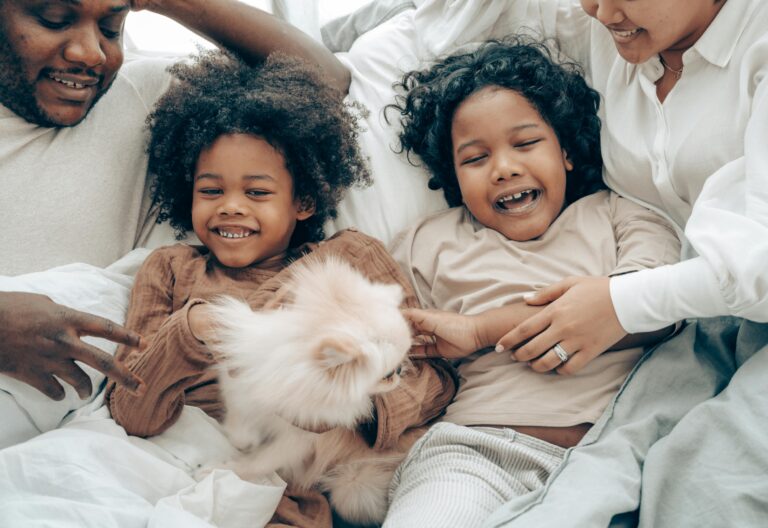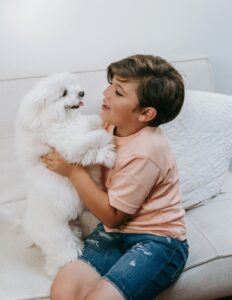Welcoming a dog into a family with children can be one of the most rewarding experiences, when done right. As a professional dog trainer, I’ve worked with countless families across New Jersey who want a peaceful, well-structured home where kids and dogs can thrive together. The secret? Consistent training that includes everyone in the household.
Whether you’re introducing a new puppy, managing an energetic adolescent dog, or refining behaviors in an older companion, these practical training tips will help bring calm to the chaos and build a strong, safe bond between your children and your dog.
Why Family Participation in Training Matters
One of the most common mistakes I see is when only one adult handles all the dog training. This often leads to confusion for the dog, especially when kids interact differently or allow behaviors that contradict training.
When kids are involved in the training process:
- Dogs learn to generalize commands across family members
- Children develop leadership and empathy
- The dog sees everyone as part of the same structure and routine
Ground Rules for Kids and Dogs
Before diving into formal training, it’s important to set some foundational rules for how kids and dogs should interact:
For Kids:
- No roughhousing or teasing
- Respect the dog’s food, crate, and resting areas
- No running and screaming near the dog, especially during downtime
For Dogs:
- No jumping on children
- No resource guarding around toys or food
- Always respond to commands from any family member, including kids
When these ground rules are consistently reinforced, your home becomes a calmer, safer place for everyone.
Best Training Exercises for Family Integration
Here are some simple yet powerful training exercises the whole family can use to build structure and improve communication:
1. The Place Command
Teaching your dog to go to a designated spot (like a mat or cot) and stay there helps create peace during family activities like meals or movie night.
If your dog is still learning impulse control, this is one of the first commands we prioritize in our Basic Obedience Program. It gives your pup a job to do and helps them practice calmness even amid kid-related distractions.
2. Structured Walks
Family walks are a great bonding opportunity, but it’s important to keep them structured. Avoid allowing your dog to pull, zig-zag, or sniff excessively when walking with kids. A structured heel teaches discipline and focus, even in a busy neighborhood park.
To make this more effective, try these leash drills that keep kids involved and build real-world obedience: How to Handle Distractions During Walks.
3. Trick Training
Trick training is a fun and low-pressure way to get kids engaged. Start with commands like “shake,” “spin,” or “crawl.” Kids love the instant feedback, and dogs enjoy the interaction.
Use treats, praise, and lots of repetition. Just make sure you coach your kids on timing and tone.
How to Keep Training Safe and Age-Appropriate
Let’s face it, toddlers and dogs don’t always mix well without guidance. Safety should always come first.
Tips by Age Group:
- Ages 2–5: Encourage quiet observation. Teach kids to toss treats onto the floor instead of feeding directly by hand.
- Ages 6–9: Introduce basic commands like sit, down, and place. Supervise closely and step in if the dog loses focus.
- Ages 10+: With good instruction, kids can take on larger roles like leading walks or practicing recall in the backyard.
According to the American Veterinary Medical Association, children under 10 account for the majority of dog bite victims, usually due to poor supervision or misunderstandings of body language. Proper training and clear boundaries protect both child and dog.
Creating a Routine That Works
Dogs and children thrive on routine. A predictable schedule makes it easier for your dog to succeed and your kids to participate.
Consider this simple daily framework:
- Morning: Short walk and basic command refresher
- Midday: Crate rest or backyard play (kids can assist with treat puzzles)
- Afternoon: Short training session or walk led by an older child
- Evening: Family meal with your dog in a place command nearby, followed by decompression time
Consistency is the real trainer here. The more the routine stays the same, the faster your dog will understand expectations.
Common Challenges and How to Fix Them
Even with the best intentions, hiccups happen. Here are a few common family-dog training issues and how to address them:
- Jumping on kids: Reinforce the “off” command. Have kids turn away and ignore the dog when jumping occurs.
- Overexcitement during play: Use short, structured games like tug with clear start and stop rules.
- Dog guarding toys from kids: Teach trade games using high-value treats to avoid conflict and reinforce trust.
If issues persist or escalate, especially around aggression or anxiety, professional guidance can help. We often work with families who thought their dog was “too much,” only to discover that structured training made all the difference.
Why Professional Training Makes the Difference
Family dynamics are unique, and sometimes DIY efforts fall short. That’s where we come in. Our customized Basic & Advanced Obedience Program is designed to include your entire household in the training journey, ensuring that your dog understands how to respond to every member of your family, not just one.
Training in a family environment isn’t just about obedience. It’s about building confidence, trust, and teamwork. And yes, even your 7-year-old can be part of that success.
Final Thoughts: A Family That Trains Together, Stays Together
The bond between a child and a dog can last a lifetime, but it starts with clear expectations and shared effort. When you involve your whole family in training, you create a household that’s not just dog-friendly, but dog-thriving.
Ready to create structure and peace at home? Let’s make your dog the perfect family companion.
Get started today with a customized training plan tailored to your household. Contact us now.


